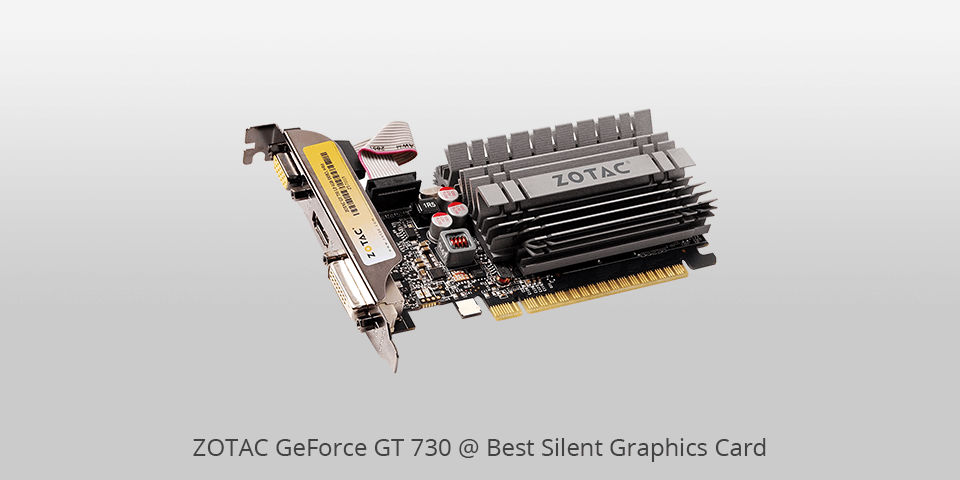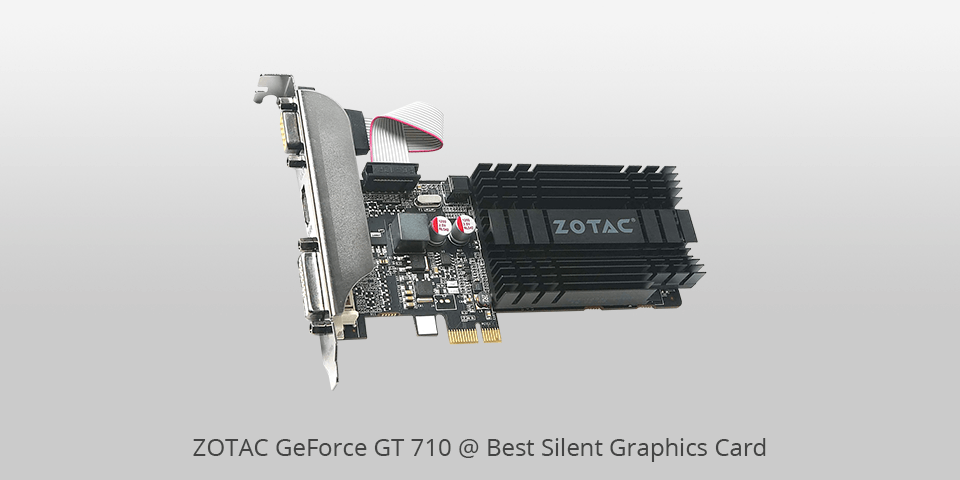Choose the best silent graphics card with active or passive cooling
If you want to build the ultimate quiet computer, you have to purchase a graphics card that has a passive cooling system, meaning it comes with a heatsink but without a fan.
However, without active cooling, you’ll have to make peace with restricted performance, which is why an actively cooled GPU is better suited for some tasks. Such a model comes with a heat sink while also employing fans to circulate air and dissipate heat.
This list goes over both active and passive silent graphics cards in the $80 to $800 price range that are provided by reputable GPU brands.
The produced noise level is the first factor you have to consider when picking the best silent graphics card. That said, the overall performance shouldn't be neglected too, especially if you plan to use your PC for gaming.
Pay attention to the number of CUDA cores, clock frequency, VRAM amount, input/output options, and available interfaces.

Noise Level: 0 dB | CUDA Сores: 384 | Core Clock: 902 MHz (boost) | Memory: 4GB DDR3 | Memory Bandwidth (Effective): 12.8 GB/s
The GeForce GT 730 is a passive quiet graphics card that can give a noticeable performance boost to your computer. It offers a low-profile build and is preconfigured with a full-height bracket.
This model has an 8-pin PCI-E 2.0 interface while also being equipped with HDMI, VGA, and DVI ports that allow you to enjoy a resolution of up to 4K.
If you’re looking for a graphic card for photo editing, then this a suitable option for such a purpose. This GPU generally provides the performance of a 1GB VRAM model but the extra VRAM comes in handy for video streaming, editing, and other media-related tasks.

Noise Level: 0 dB | CUDA Сores: 384 | Core Clock: 1506 MHz (boost) | Memory: 2GB GDDR5 | Memory Bandwidth: 48 GB/s
The Asus GeForce GT 1030 is a reliable GPU that is powerful enough to allow running AAA games on medium settings. This model is a low profile graphics card that comes with a low-profile bracket, which makes it easy to install into any compact computer case.
The GT 1030 is also supplied with GPU Tweak II technology that allows you to conveniently customize the performance. You can use it to enable overclocking as well as turn on the game booster mode that closes unessential tasks.
Additionally, this model provides DirectX 12 support, allowing you to get better performance in games that utilize it.

Noise Level: 0 dB | CUDA Сores: 192 | Core Clock: 954 MHz (boost) | Memory: 1GB GDDR5 | Memory Bandwidth: 40 GB/s
ZOTAC GeForce GT 710 relies on fanless cooling technology, which allows it to work silently. Regardless of whether you need a quiet GPU for a compact PC case or system servers, this graphics cards for multiple monitors is the optimal choice for anyone interested in connecting another monitor or wanting to boost the performance of their outdated built-in GPU chip.
This model relies on NVIDIA Kepler architecture and offers a half-height/half-length form factor, making it incredibly easy to fit into small cases. This graphics card has pleasantly modest power consumption requirements and never goes over 25W of power no matter the load.

Noise Level: 35 dB | CUDA Сores: 3584 | Core Clock: 1837 MHz (boost) | Memory: 12GB GDDR6 | Memory Bandwidth: 360 GB/s
Gigabyte RTX 3060 employs a WindForce 3X heatsink and comes with three 80mm alternating rotation fans, which can be used in semi-passive mode. The dissipating aluminum body gets rid of the warmth received from 3 copper heat pipes, which offer the perfect fit for the specifications of this graphics card.
This graphics card under $400 offers a TDP of 170W while maintaining its relatively modest requirements even when used in overclocked mode.
Supported by NVIDIA's 2nd gen RTX architecture and further facilitated by the WINDFORCE cooling technology, the RTX 3060 delivers mesmerizing graphics, incredibly high framerates, and AI acceleration provided by its advanced RT Cores and Tensor Cores that enable you to play the latest games with fantastic visual fidelity.

Noise Level: 37 dB | CUDA Сores: 1408 | Core Clock: 1785 MHz (boost) | Memory: 6GB GDDR5 | Memory Bandwidth: 192 GB/s
This is probably the best silent graphics card for users that want to game in 1080p resolution but can’t afford to get the more expensive GTX 1660 Ti version. You’ll be able to enjoy a steady 60fps framerate in most games even on high settings.
The offered performance is also more than enough if you want to use your computer as an entertainment system for watching movies and streaming Netflix series, graphic design, or 4K video editing and rendering.
Additionally, the size of this GPU for 1080p is only 8.5”, which makes it a great fit for 99% of PC cases.

Noise Level: - | CUDA Сores: 768 | Core Clock: 1392 MHz (boost) | Memory: 4GB GDDR5 | Memory Bandwidth: 112 GB/s
The GTX 1050 Ti comes with high-quality capacitors, ferrite core chokes, and an upgraded build. Thanks to the Palit StormX thermal design, this graphics card runs rather silently despite having a fan.
This 4GB graphics card supports smooth video playback in 4K 60fps while relying on hardware acceleration and barely putting any stress on the CPU.
Due to the inclusion of Nvidia’s proprietary “creative” drivers, this GPU is a particularly good fit for people who frequently use Adobe Lightroom or Photoshop.

Noise Level: 31 dB | CUDA Сores: 4608 | Core Clock: 2065 MHz (boost) | Memory: 16GB GDDR6 | Memory Bandwidth: 512 GB/s
The Red Dragon RX 6800 is a silent GPU with state-of-the-art fans that come with angled blades, which serve to provide superior air circulation while ball bearings secure more fluid rotation. When the graphics card is running at full capacity, it produces a noise level of 32dB, but you can lower it a bit by enabling the quiet mode in the BIOS parameters.
This graphics card for video editing allows freely going from silent to overclock mode and vice versa, providing full control over the GPU’s performance at any given moment.
This model is packed with a stunning 16GB of VRAM, which allows it to excel at rendering 3D scenes and running GPU-intensive games. It also offers ray tracing support and is a great fit for playing even the most recent games in 4K resolution.
| IMAGE | NAME | FEATURES | |
|---|---|---|---|

|
ZOTAC GeForce GT 730
OUR CHOICE
|
CHECK PRICE → | |

|
Asus GeForce GT 1030
LOW PROFILE
|
CHECK PRICE → | |

|
GIGABYTE GeForce RTX 3060
SEMI-PASSIVE
|
CHECK PRICE → |
When picking the best silent graphics card for your PC, always factor in what you’re going to use it for. If you’ll limit your activities to web browsing and watching movies in high quality, then you can find a good passive GPU with a noise level of 0dB.
Meanwhile, a graphics card for Fortnite or other recent games has to be more powerful, be supplied with active cooling, and provide a noise level of 30dB or higher.
CUDA cores. The produced noise level isn’t directly tied to the number of CUDA cores and a higher quantity of such components is beneficial for delivering increased processing power. As a result, the graphics card offers better performance but at a cost of increased temperatures, which, in turn, demand more powerful cooling.
Clock speed. The faster the speed, the better the performance of your graphics card. If you adjust the GPU to a higher speed than the one set by the manufacturer, it will enter overclocking mode. Overclocking your graphics card allows you to enjoy improved performance but increases the workload for the fans. Meanwhile, running the GPU below maximum output lets the fans work more quietly.

VRAM. This characteristic refers to the random-access memory used for containing all the image data that has to be processed. 4GB of VRAM is a solid amount if you’re doing everything in 1080p resolution. However, if you plan to play games or do 3D modeling in 1440p or 4K resolution, you should get a GPU with at least 8GB of VRAM, although a 16GB option would be even better.
Memory bus and width. You can imagine a memory bus as a road lane between the GPU and the RAM of your PC. The higher the memory bus value (64-bit, 128, 192, 265, etc.) the better and more streamlined traffic your system will enjoy, as it will receive a broader data flow.